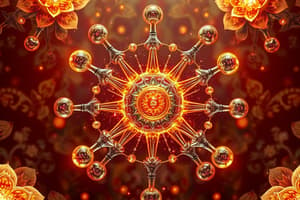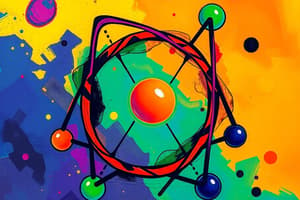Podcast
Questions and Answers
Which part of the atom is responsible for chemical bonding?
Which part of the atom is responsible for chemical bonding?
Electrons
What are valence electrons?
What are valence electrons?
The electrons in the outermost shell of an atom.
How many valence electrons do most atoms need to have a complete outer shell and be satisfied?
How many valence electrons do most atoms need to have a complete outer shell and be satisfied?
8
Which two elements only need two valence electrons?
Which two elements only need two valence electrons?
Why do the elements you named need only two valence electrons?
Why do the elements you named need only two valence electrons?
How many valence electrons do alkali metals have?
How many valence electrons do alkali metals have?
How many valence electrons do alkaline earth metals have?
How many valence electrons do alkaline earth metals have?
Define an ion.
Define an ion.
If an element gives away an electron, will it form a positive or negative ion?
If an element gives away an electron, will it form a positive or negative ion?
If an element gains an electron, will it form a positive ion or a negative ion?
If an element gains an electron, will it form a positive ion or a negative ion?
What is the difference between a cation and an anion?
What is the difference between a cation and an anion?
How do ionic bonds form?
How do ionic bonds form?
How do covalent bonds form?
How do covalent bonds form?
Identify the type of bond for Carbon.
Identify the type of bond for Carbon.
Identify the type of bond for Chlorine.
Identify the type of bond for Chlorine.
Identify the type of bond for Magnesium.
Identify the type of bond for Magnesium.
How do you determine if a compound is covalent?
How do you determine if a compound is covalent?
How would you determine if a compound is ionic?
How would you determine if a compound is ionic?
What two things are found in the nucleus of the atom?
What two things are found in the nucleus of the atom?
Where is a 'Group' found on the periodic table?
Where is a 'Group' found on the periodic table?
Where is a 'Period' found on the periodic table?
Where is a 'Period' found on the periodic table?
Group 1 on the periodic table is called?
Group 1 on the periodic table is called?
Group 2 on the periodic table is called?
Group 2 on the periodic table is called?
Where are noble gases found on the periodic table?
Where are noble gases found on the periodic table?
Where is the general location of nonmetals on the periodic table?
Where is the general location of nonmetals on the periodic table?
What are some examples of metalloids?
What are some examples of metalloids?
Where are halogens found on the periodic table?
Where are halogens found on the periodic table?
Where are transition metals found on the periodic table?
Where are transition metals found on the periodic table?
What do the charges on each element of a compound have to be for it to be considered neutral?
What do the charges on each element of a compound have to be for it to be considered neutral?
Which type of bond (covalent or ionic) has a lower melting point?
Which type of bond (covalent or ionic) has a lower melting point?
Which type of bond has a high melting point?
Which type of bond has a high melting point?
Elements on the periodic table are arranged how?
Elements on the periodic table are arranged how?
What is the difference between an endothermic and exothermic reaction?
What is the difference between an endothermic and exothermic reaction?
What are polyatomic ions?
What are polyatomic ions?
What is a base?
What is a base?
What is an acid?
What is an acid?
Provide an example of a base.
Provide an example of a base.
Provide an example of an acid.
Provide an example of an acid.
What is SO3?
What is SO3?
What is XeF6?
What is XeF6?
What is N2O4?
What is N2O4?
What is PCl5?
What is PCl5?
What is SiBr4?
What is SiBr4?
What is ClF3?
What is ClF3?
What is Cl2O7?
What is Cl2O7?
What is P4O10?
What is P4O10?
What does the term polar describe?
What does the term polar describe?
What does the term non-polar describe?
What does the term non-polar describe?
Study Notes
Atomic Structure and Chemical Bonding
- Electrons are responsible for chemical bonding, determining how atoms interact.
- Valence electrons are the outermost electrons; they dictate an atom's bonding behavior.
- Most atoms require 8 valence electrons for a stable outer shell, known as the octet rule.
- Hydrogen and Helium are exceptions, needing only 2 valence electrons to fill their first shell.
Types of Elements
- Alkali metals possess 1 valence electron, making them highly reactive.
- Alkaline Earth Metals have 2 valence electrons and are reactive, but less so than alkali metals.
- Nonmetals are typically located on the far right of the periodic table, except for hydrogen in the top left corner.
- Halogens can be found in Group 7 of the periodic table, known for being highly reactive.
- Noble gases in Group 8 have a complete outer shell, making them stable and unreactive.
Ions and Types of Bonds
- An ion is defined as an atom or molecule with a net electric charge resulting from the loss or gain of electrons.
- If an atom loses an electron, it forms a positive ion (cation); gaining an electron forms a negative ion (anion).
- Cations have more protons than electrons, while anions have more electrons than protons.
- Ionic bonds occur through the complete transfer of electrons, usually between metals and nonmetals.
- Covalent bonds involve the sharing of electrons, typically between nonmetals.
Periodic Table Insights
- A "Group" in the periodic table is a vertical column; elements in the same group exhibit similar chemical properties due to equivalent valence electrons.
- A "Period" is a horizontal row, where atomic numbers increase from left to right, with lower similarities in properties between elements.
- Transition metals occupy columns 3 through 12 and have variable oxidation states and properties.
- The general arrangement of the periodic table is based on increasing atomic number and, generally, atomic mass.
Chemical Reactions
- Endothermic reactions absorb heat, while exothermic reactions release heat.
- Polyatomic ions consist of more than one atom connected by covalent bonds, behaving as a single unit in chemical reactions.
Properties of Acids and Bases
- A base is defined as a proton acceptor, while an acid is a proton donor, fundamental concepts in acid-base chemistry.
- Examples include NaOH (base) and lemon juice (acid).
Molecular Characteristics
- Polar molecules have separated positive and negative charges, leading to dipole moments.
- Non-polar molecules feature equal electronegativity among atoms, resulting in uniform electron distribution.
Chemical Formulas
- Notable compounds include:
- SO3: Sulfur trioxide
- XeF6: Xenon hexafluoride
- N2O4: Dinitrogen tetroxide
- PCl5: Phosphorus pentachloride
- SiBr4: Silicon tetrabromide
- ClF3: Chlorine trifluoride
- Cl2O7: Dichlorine heptoxide
- P4O10: Tetraphosphorus decoxide
Conclusion
- Understanding atomic structure, types of bonds, and the nature of acids and bases is crucial for mastering chemical concepts.
- The periodic table serves as a vital tool in predicting element properties and behaviors based on their arrangement and group characteristics.
Studying That Suits You
Use AI to generate personalized quizzes and flashcards to suit your learning preferences.
Description
Test your knowledge on the atomic structure with this quiz focused on electrons and chemical bonding. Explore concepts such as valence electrons and their importance in forming chemical compounds. Perfect for students studying basic chemistry.




